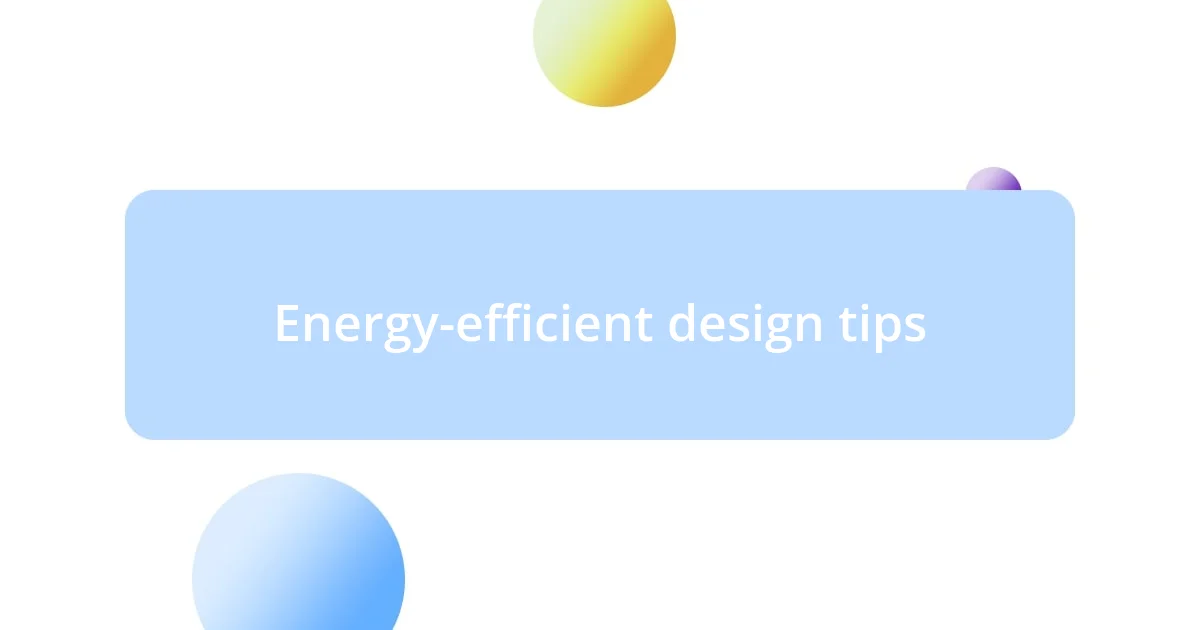Key takeaways:
- Eco-friendly renovations improve home health, comfort, and property value through choices like sustainable materials and energy-efficient appliances.
- Incorporating natural lighting, effective insulation, and low-VOC paints can enhance energy efficiency and indoor air quality.
- Budgeting creatively for eco-friendly upgrades, such as sourcing local materials and leveraging grants, can lead to significant long-term savings.

Understanding eco-friendly renovations
Eco-friendly renovations are all about creating a healthier home while minimizing our impact on the planet. I remember when I decided to switch my flooring from conventional laminate to sustainable bamboo. It not only felt great to make such a responsible choice, but I also found the aesthetic warmth of bamboo truly uplifting. Have you ever considered how small changes can make a big difference in your living space?
When I think about eco-friendly renovations, it’s not merely about using green materials; it’s also about energy efficiency. For instance, adding better insulation can drastically reduce energy bills and contribute to a more comfortable home. Who wouldn’t want to save money while also being kinder to the Earth?
I’ve also learned that choosing low-VOC (volatile organic compounds) paints is essential for indoor air quality. Initially, I was skeptical about the difference it would make, but the fresh smell of my newly painted room—without the harsh chemical odors—was a revelation. It made me realize that sustainable choices can enhance our daily lives in ways we might overlook.

Benefits of eco-friendly homes
Eco-friendly homes offer numerous advantages, not only to the environment but also to our well-being. For instance, when I installed energy-efficient windows, my home became noticeably cozier, and I felt a sense of pride knowing I was reducing my carbon footprint. It’s remarkable how a simple change can elevate your comfort while supporting sustainability.
Moreover, living in an eco-friendly environment can lead to better health outcomes. After replacing my traditional air conditioning unit with a more sustainable model, I noticed a significant improvement in air quality. The difference was palpable; I could breathe easier, which made me realize the long-term health benefits of choosing eco-friendly options. Isn’t it interesting how our spaces can profoundly impact our overall well-being?
Finally, eco-friendly renovations can enhance property values. When I renovated my kitchen using energy-efficient appliances, I not only enjoyed a beautiful and functional space, but I also found my home appreciated significantly over time. The financial benefits of eco-friendly homes are often overlooked, yet they present a compelling reason to consider these choices for both our wallets and the planet.
| Benefit | Description |
|---|---|
| Energy Efficiency | Reduces energy bills and enhances comfort. |
| Health Improvement | Better indoor air quality leads to improved health outcomes. |
| Property Value | Eco-friendly homes often appreciate more over time. |

Key materials for renovations
When considering key materials for eco-friendly renovations, I can’t help but reflect on the choices I made during my own projects. For instance, I opted for reclaimed wood for my kitchen cabinets, and it not only gave the space a unique character but also felt like I was breathing new life into something special. Each knot and grain tells a story, and that connection to the past adds a warmth that’s hard to replicate with new materials.
Here’s a list of some essential eco-friendly materials to consider for renovations:
- Reclaimed Wood: Offers a rustic aesthetic and reduces demand for new lumber.
- Bamboo: A highly renewable resource that’s durable and beautiful for flooring or cabinetry.
- Cork: An excellent insulator that is also biodegradable and comfortable underfoot.
- Recycled Glass: Great for countertops or backsplash; comes in various colors and styles.
- Natural Stone: Timeless and durable, with a lower environmental impact than synthetic options.
- Low-VOC Paints: Enhance indoor air quality while providing vibrant options for your design.
In my experience, each material choice is an opportunity to reflect my values while creating a space that feels personal and inviting. I remember feeling excited searching for recycled glass tiles and discovering such a vibrant array of colors. It sparked a creativity within me that translated beautifully into my bathroom renovation. By embracing these eco-friendly materials, I felt not just the satisfaction of choosing sustainably, but also the joy of crafting a home that truly resonates with who I am.

Energy-efficient design tips
I’ve discovered that one of the simplest yet impactful energy-efficient design tips is maximizing natural lighting. When I switched to larger windows and strategically placed mirrors, I couldn’t believe the difference it made in my home. Not only did the spaces feel brighter, but I also noticed a significant decrease in my reliance on artificial lighting, which ultimately affected my energy bills. Have you ever considered how the orientation of your windows could change the ambiance of your home?
Another crucial element is choosing the right insulation materials. During my last renovation, I opted for spray foam insulation, and the change was incredible. It made my house feel like a fortress against the elements, while also reducing my heating and cooling expenditures. I felt a deep sense of security knowing that I was creating a sustainable environment by improving energy efficiency. What insulation material have you thought about for your home?
Lastly, I can’t emphasize enough the benefits of energy-efficient appliances. When I replaced my old refrigerator with a high-efficiency model, I experienced a stark reduction in energy consumption. I was pleasantly surprised by how quiet it ran, too; it felt like a small luxury. It’s fascinating how choosing the right appliances not only saves money but also contributes to a greener planet. Have you looked into how much energy your appliances use? You might be shocked at the potential savings!

Sustainable practice in renovations
When it comes to sustainable practices in renovations, I’ve found that the little details can make a big difference. For example, during my last project, I prioritized using eco-friendly adhesives. I vividly remember the moment I discovered a low-VOC adhesive that had minimal odor compared to traditional options. It felt great to breathe easier while working, and it highlighted how even something as simple as glue can impact indoor air quality.
Another fascinating aspect of sustainability is the concept of adaptive reuse. I decided to transform an old barn door into a sliding closet door in my home. Not only did it serve as a fantastic conversation piece, but it also reduced waste by giving new life to materials that would have otherwise been discarded. Have you ever thought about how incorporating reclaimed elements can elevate your space while promoting sustainability?
I’m also a strong advocate for incorporating plants into renovation designs. I added a green wall in my living room, and it was an eye-opening experience. The vibrant colors and textures brought a sense of peace that I hadn’t anticipated, and the air quality improved remarkably. Have you considered how the inclusion of greenery could transform a room? The emotional vibe and connection to nature are not just aesthetically pleasing; it genuinely fosters a healthier living environment.

Budgeting for eco-friendly projects
Budgeting for eco-friendly renovations requires careful planning, but I’ve learned that a little creativity can stretch your dollars farther than you might expect. During my last project, I focused on sourcing materials from local suppliers, which not only saved on shipping costs but also revealed some hidden gems that I wouldn’t have found in big box stores. Have you ever thought about how buying locally can add character to your home while keeping costs down?
One key strategy I embraced was prioritizing investments. For instance, I decided to allocate a larger portion of my budget towards high-quality insulation, recognizing that this would pay off in energy savings over time. I still remember the satisfaction I felt when my energy bills dropped significantly during the first winter after my renovation. It was a reminder that sometimes, spending a bit more upfront can lead to long-term rewards. What aspects of your renovation do you believe deserve your biggest investment?
Additionally, I keep a close eye on available grants or tax incentives for eco-friendly initiatives. There was a moment when I discovered a local program that helped subsidize the cost of solar panels. That unexpected windfall not only made solar an affordable option for me but also deepened my sense of responsibility toward the environment. Have you checked for similar programs in your area? It might just be the key to making that eco-friendly upgrade you’ve been dreaming about!

Personal success stories in renovations
One of my personal success stories in eco-friendly renovations revolves around my kitchen remodel. I switched to energy-efficient appliances, and I still remember the thrill of seeing the energy rating labels shine like badges of honor. Once I noticed a substantial reduction in my energy bills, it felt like the appliances were not just tools – they had become partners in my quest for sustainability. Have you ever considered how much impact your appliances can have on both your wallet and the environment?
Another proud moment came when I decided to embrace natural finishes in my home office space. By using bamboo flooring, I created a stunning aesthetic that was also sustainable. The first time I walked barefoot on it, I felt a connection to nature that transformed my productivity levels. It was incredible to realize that each step was a reminder of my commitment to living greener. Can you think of how embracing natural materials could elevate your workspace?
One renovation project that really touched my heart involved creating a rain garden in my backyard. I remember watching the rainwater flow into it after a storm, redirecting it from my foundation and nourishing the plants instead. There’s something truly rewarding about seeing nature thrive because of your efforts. Have you ever thought about how such small changes can create a big impact on your environment? It’s moments like these that really reinforce my passion for eco-friendly living.












